|
Cruising
the Baltic from Stockholm to Helsinki
Section III: Hangö to Helsinki |
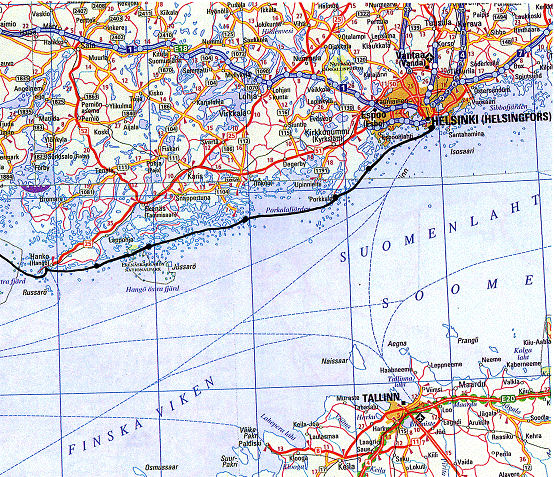 Day 12 - Small island east of Hangö Day 13 - Small island south of Torsö
Day 14/15 - Small island west of
Bågaskär
Day 16/17 - Porkkala
Day 18 - Small island east of Porkkala
Day 19 - Small island south of
Suvisaaristo
Day 20 - Small island of Rönnskär, Helsinki The cove in which we moored was open to
north. During night the wind turned to north/northeast and increased,
which meant that we had some difficulties in setting off the next
morning. By some manoeuvring and warping, we got the boats into a
position to motor out of the cove. Everything went well and we were
able to set sail on a reach eastwards.
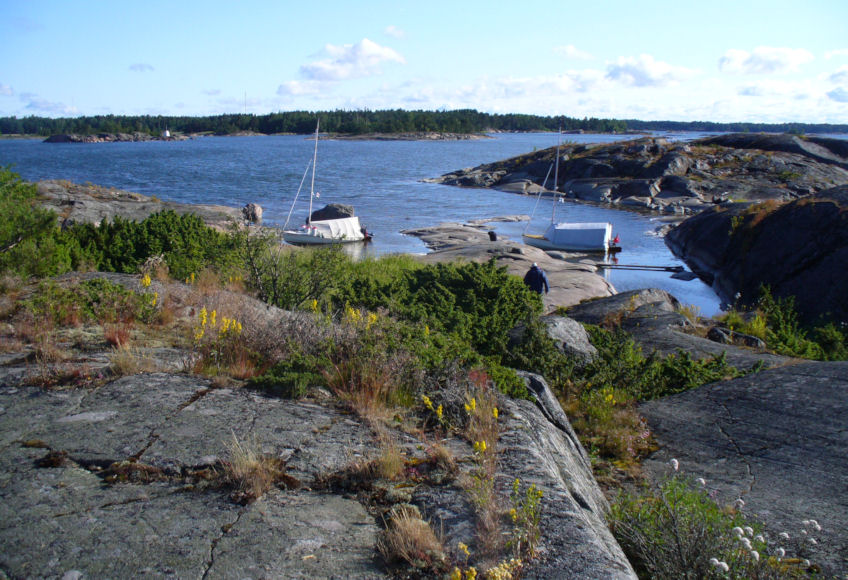 The wind blowing
directly into the cove made getting away next morning
more difficult because of the many rocks just beneath the
surface around the entrance. The boats therefore needed to initially be moved to the far side of the inlet. - click here for larger image There is, in practice, just one main
inshore pleasure boating lane in
an east - west direction on the Finnish south coast. It is along this
route
that all the yachts and powerboats sail - at the beginning of July
going
westwards, and by the end of July, returning eastwards. We often sailed
parallel to this lane, winding around small islands, in and out through
narrow
sounds, where we could usually find good night anchorages.
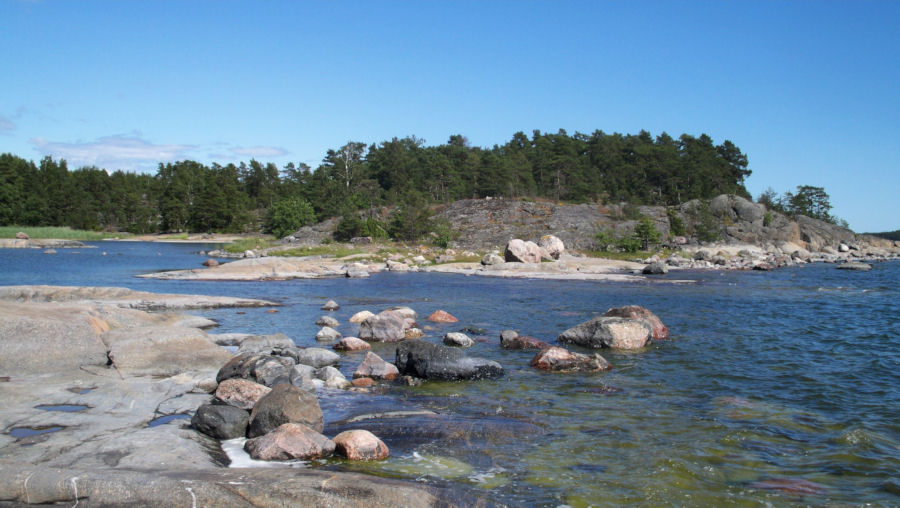 There
was much interest from the crews in pleasure boats, keeping to
their well marked channel nearby, when
we carried out a survey of this narrow gap between two islands, before sailing through to stop for a lunch break. 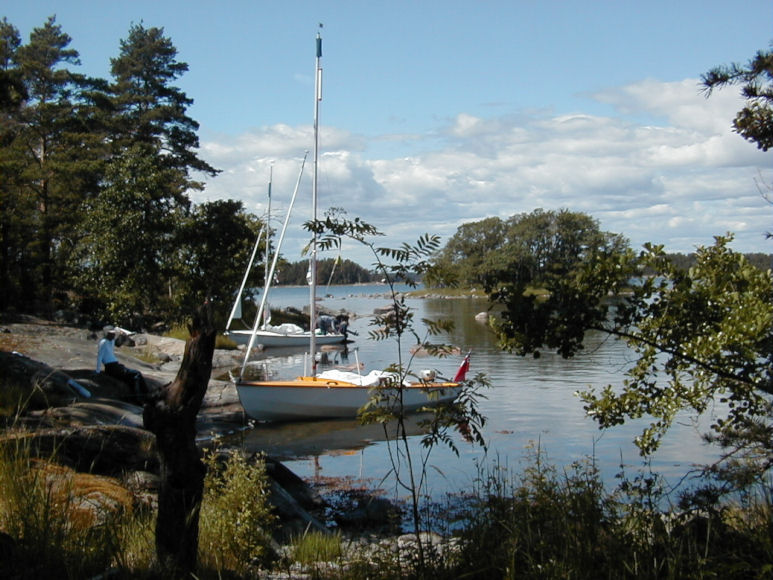 There
were many idyllic stopping points along our route, but this
photo, taken by Martin, probably epitomises just what an incredibly
beautiful
an area it is to sail, and how lucky we were, certainly up to this
point, with
the weather. We had managed to sail every single day, and were yet to
be
delayed by either too much wind, or none at all.
Sometimes, we had to look for a little
while, particularly
where it became more difficult to find islands without houses. Whenever
we
found a suitable inlet, there was often a house close to the beach. The
difficulties to find suitable overnight stopping places increased
substantially
the closer we approached Helsinki.
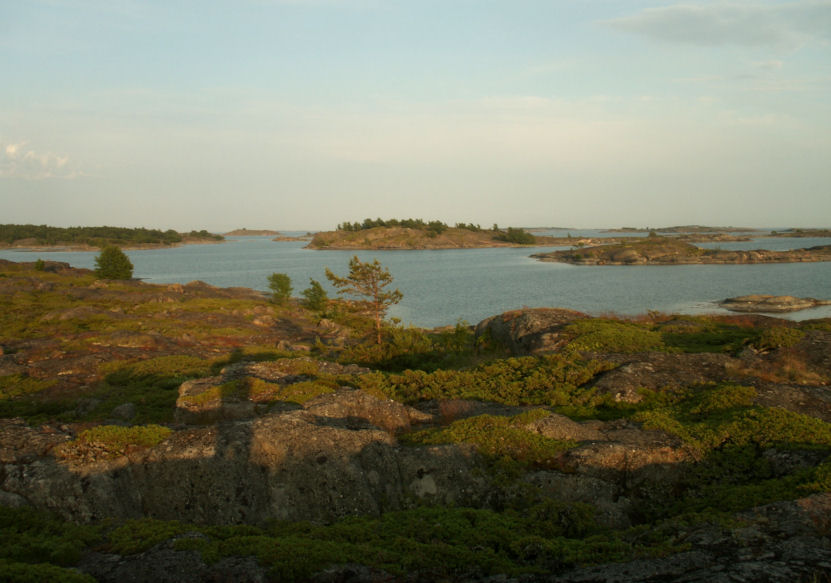 The
opportunity for getting lost when sailing around and between the
islands is well illustrated in this photo,
which was taken before we neared the more habited areas nearer to the large towns and cities on the mainland. 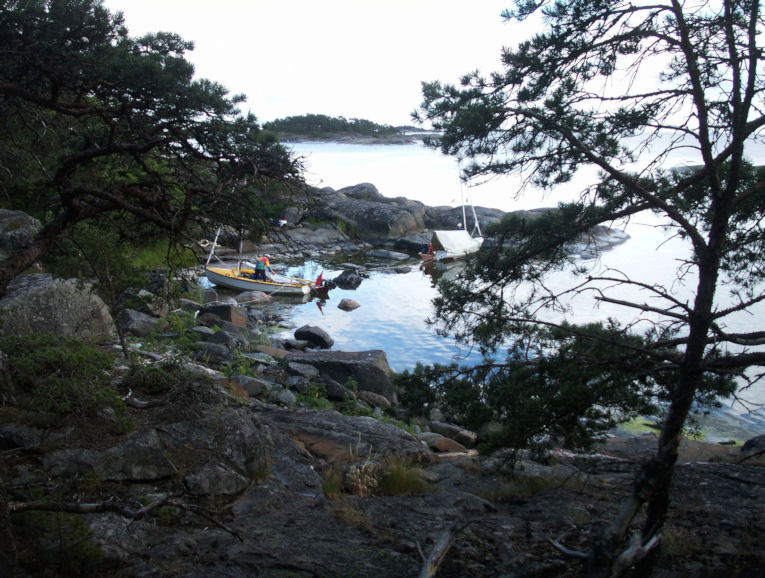 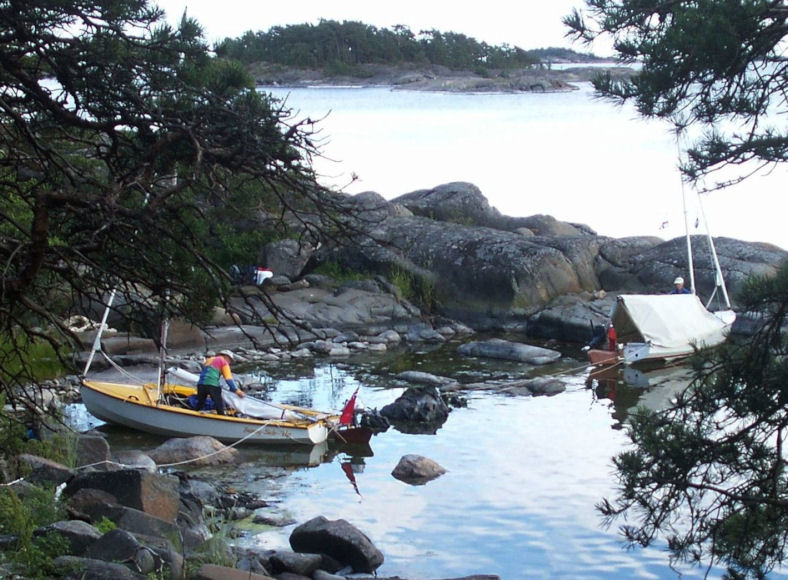 There
were two quite convenient anchorages at this mooring site, with
plenty of nearby rocks to secure
the mooring lines to. Both boats carried two good anchors, which were used extensively at each mooring site. 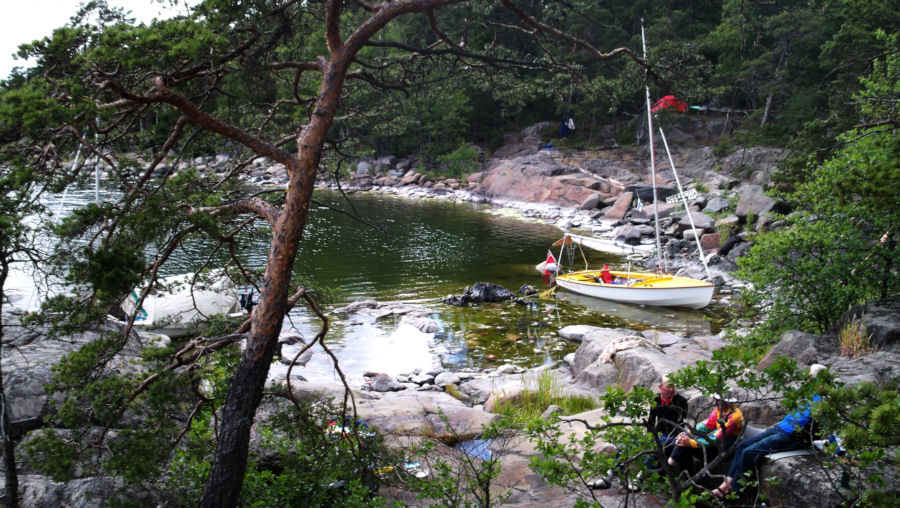 Åke
and Sten gave each of their tent pitch sites a 'star' rating. This
particular site rated only a 3* - the distance
from the tent to our 'eating and relaxation area' in the fore-ground may have precluded it from a higher rating! The weather became more and more
unsettled during our third
week of sailing. Just before the wide Bay of Porkkala, we had to seek
shelter
from a gale with heavy rain, forecast for the next day from south.
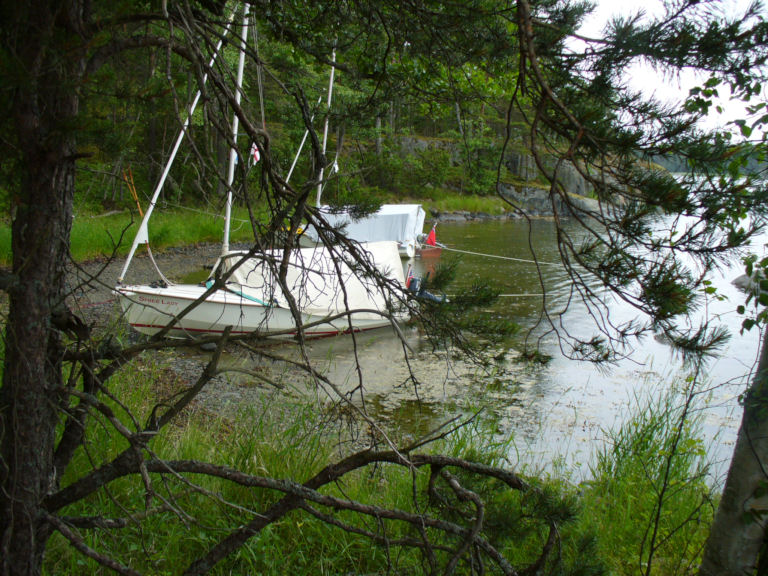 We
managed to find an ideally sheltered spot for the wind and rain
forecast for the next day.
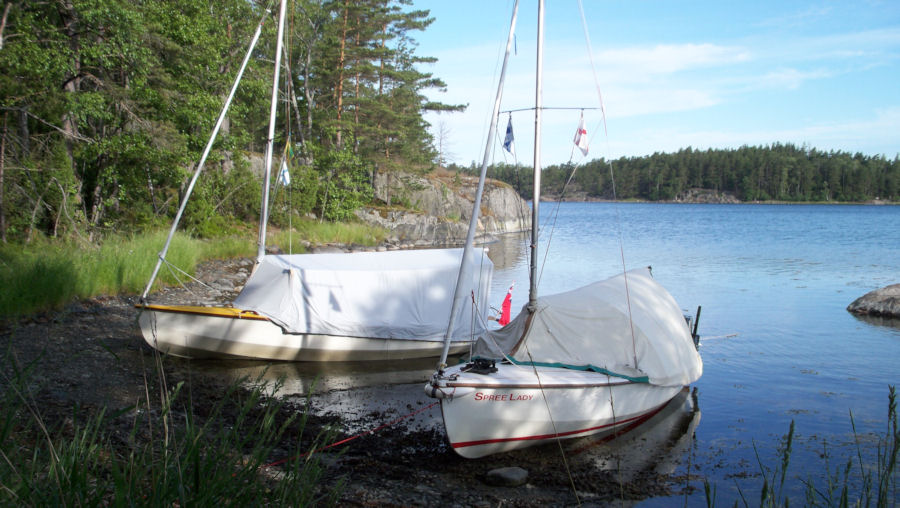 We
walked around the island the next morning, before the gale blew in
and confined us to our tents for the rest of the day.
A couple of days later, when the
conditions were better, we crossed the
10-mile-wide bay, with a gale warning for the next night hanging over
us. We
put into port safely in the Porkkala Marina, where we had to wait for
48 hours
while the gale roared with the rain beating on the boom tents during
the night.
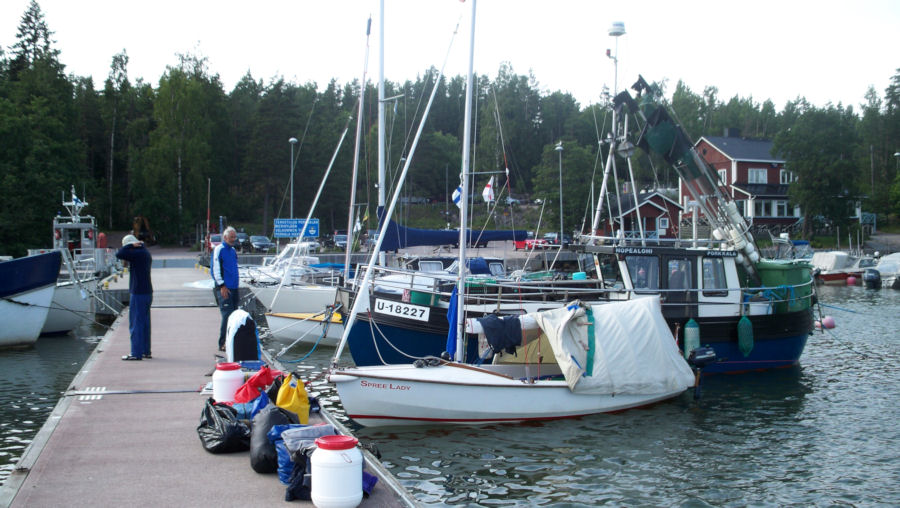 The
visitors' moorings were on the other side of the pontoon, and fully
exposed to the gale force winds
we experienced over the next two days. We were allowed to moor on the better protected side. But we had nothing to complain about.
There was a store with a café, as
well as a small summer restaurant. We were frequent visitors to both
places.
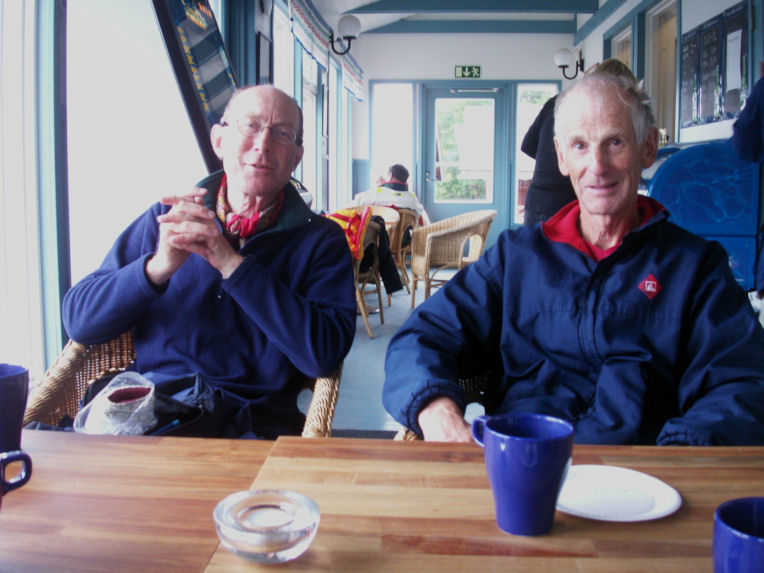 Sten
and Ralph enjoying a mid-morning cup of coffee at the marina
café
and small shop. We also made use of the sauna. Our Wayfarers created
some
interest with local sailors, who were kind enough to advise us where we
could
best stay on reaching Helsinki.
The wind then eased, and we were able to
set sail, heading for
St. Svartö, which was just a few miles from Porkkala Marina. It
was lovely to
get back to a natural anchorage again, to pitch the tent, and enjoy the
stillness of nature. After some time, lots of yachts came to the
island, which
was be a well-known anchorage for sailors along this part of the coast.
The
island belongs to the City of Helsinki, which had provided jetties and
toilets
to make it more comfortable for visiting yachtsmen. We moored at a
jetty for
small boats, away from the other yachts.
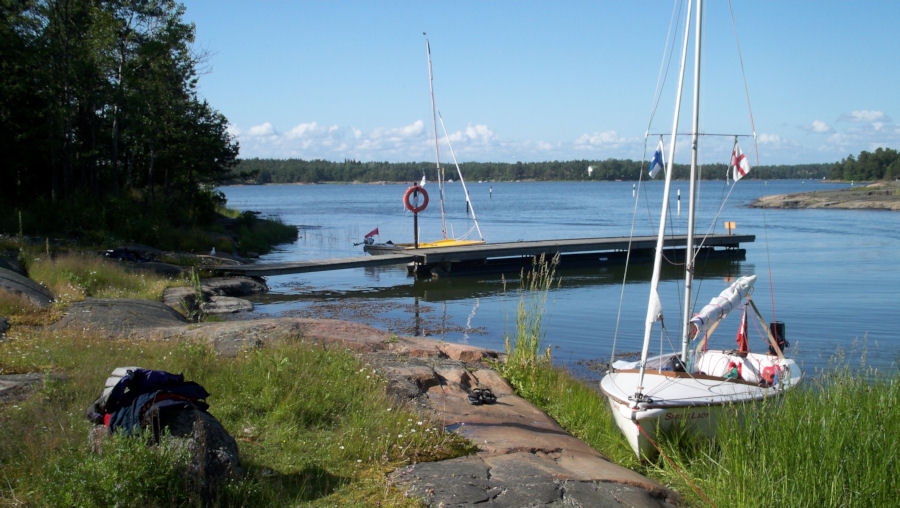 Spree Lady pulled up on a sandy
part of the shore, whilst Sunny-Side-Up
is
moored on the far side of the jetty, with a stern line to the shore. Saturday started with sunny weather and a
moderate south to southeasterly wind. We were rapidly approaching
Helsinki. There were houses on every
island. In every creek shown on the chart where there appeared to be a
good
place to stop, there was a house. (There is a well defined etiquette in
Scandinavia that you do not land a small craft in the vicinity of a
shore-side
residence in such a way as to intrude on their absolute privacy - any
such
possible landing place became known as an 'absolutely not' stopping
point to
our English friends)!
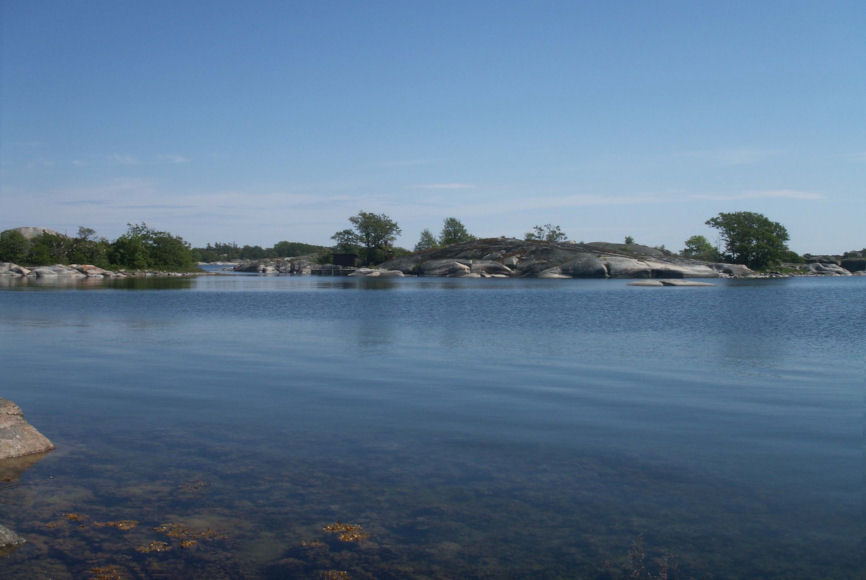 Our
stay in Porrkala had been an expensive one, since the marina had
only one charge per boat, per overnight stop, no matter what size the
boat was,
and there was no reduction for our small Wayfarers. However, this was
more than
made up for by local sailors informing us of ideal stopping points on
our route
for the remainder of our journey to Helsinki. - click here for larger image
We had heard from a yachtsman in Porkkala
that there was a
public amenity island owned by the town of Esbo, where we could stop
for the
night. After some searching, we found the island - named Kaparen
(the Privateer), and even a landing
spot with a sandy beach (to the delight of the Englishmen), where we
could
pull up the dinghies.
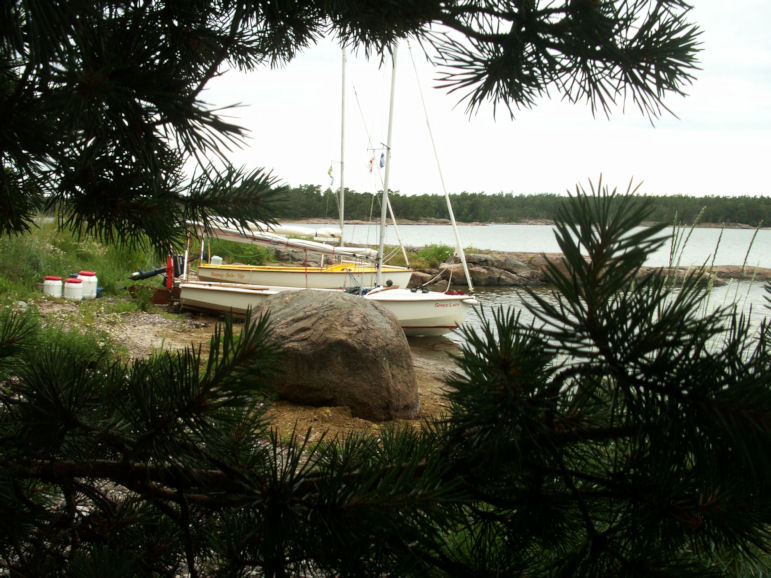 There
were very few sandy beaches for us to roll the boats up out of
the water, our preferred option for an overnight stop. It was most
useful for
us that Finland seemed to have the tradition of towns and cities owning
islands, purely for the benefit of boat owners to use for their
recreation.
Unfortunately, we were not allowed to
camp on the island, so all four
of us had to sleep in the boats. The weather was unstable, with rain
now and
then, but we were well protected from the southeasterly wind.
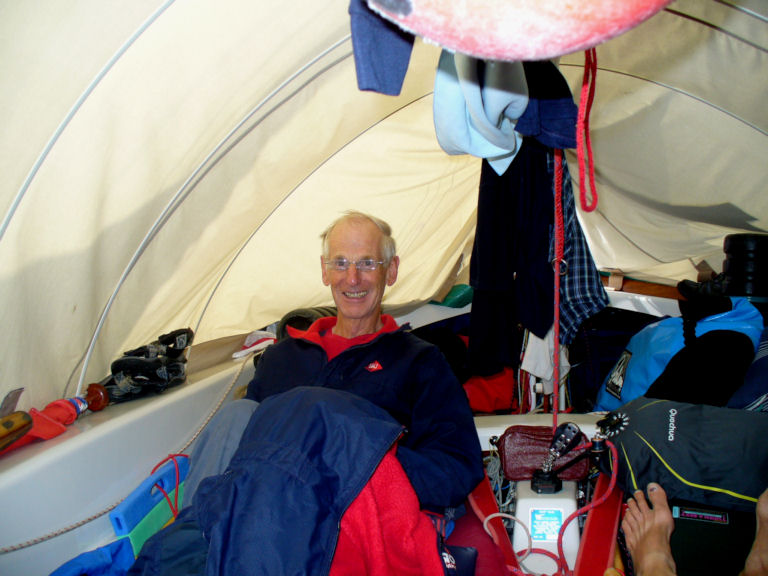 One
of the advantages of pulling the boats ashore was that many of the
fully waterproof items of equipment could be easily put outside the
boat, and
stored on the shore. Even with this advantage however, the area inside
the boat
still tended to be somewhat cluttered. Photo taken by Åke after
an early
morning cup of tea had been brewed.
The morning of our final day's sail was
wet, as it had rained
a lot during the night. Heavy clouds were blowing in with a fresh
south-westerly breeze. We set off after a quick breakfast. Sheltered by
the
islands, we did not feel the power of the wind in the Bay of Finland,
but
exposed to the sea, we met waves that we hadn't encountered previously.
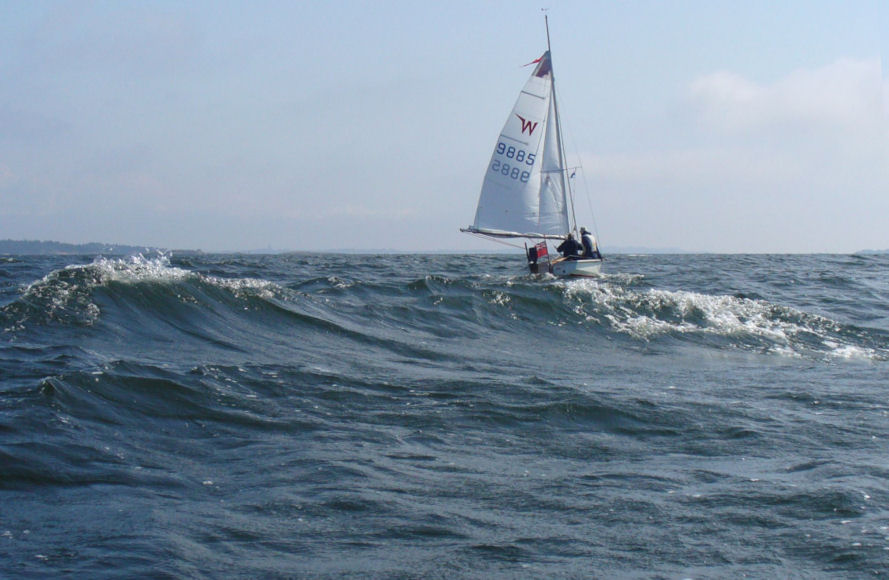 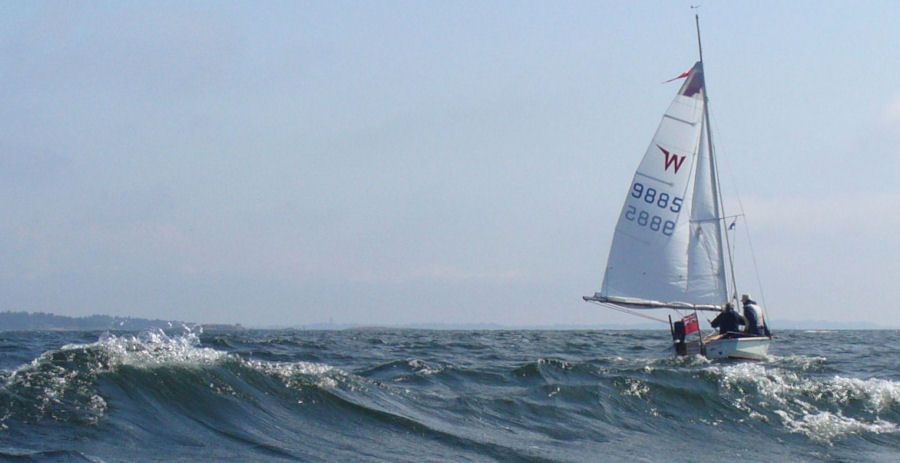 We ran before the wind, surfing towards
Helsinki, with a reef in the
main and the genoa furled in. We must occasionally have done more than
six
knots. And suddenly, we were there, at Rönnskär, a little to
the south of
Helsinki, our final destination. Protected by the island, Ralph sailed
in,
unconcerned by the buoyage, and straight over the shallow bank, right
up to the
jetty.
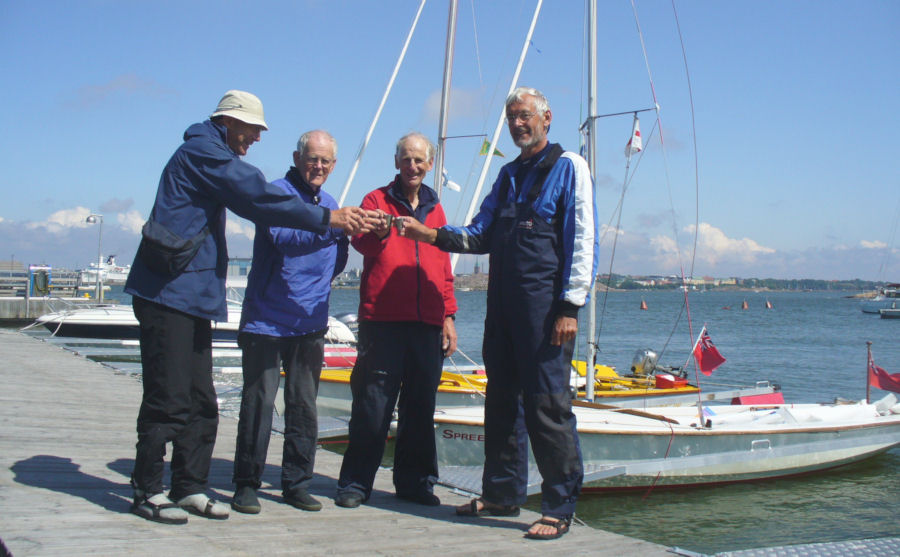 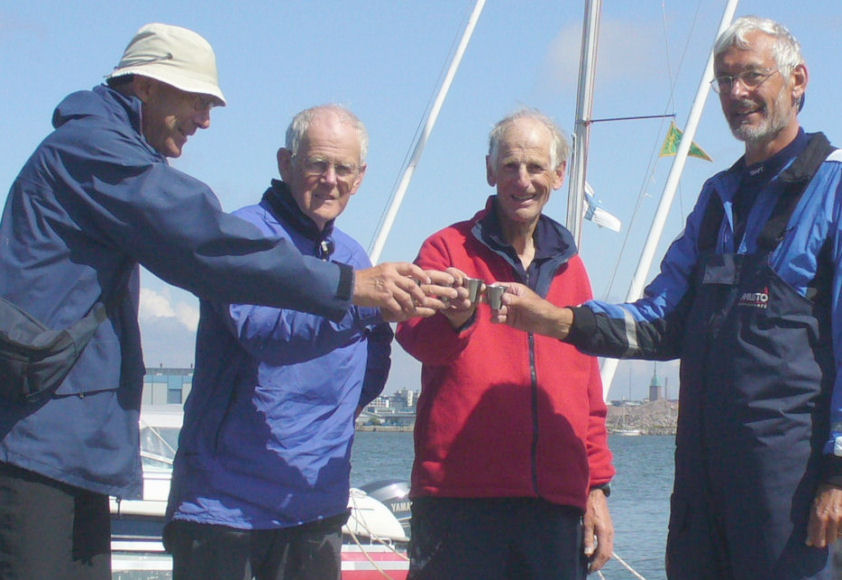 The
island of Rönnskär, is a public amenity island, owned by the
city
of Helsinki, for people to visit, either in their own boats, or by
using a
public ferry with a half-hourly service at peak times. We were most
fortunate
to be told about this island whilst we were in Porrkala, since we had
planned
to stay at one of the city's Yacht Clubs, but this was much more
comfortable -
and far cheaper!
We had made it! We had sailed more than
300 miles in 21 days in small
dinghies. We came ashore and celebrated our success with a tot of the
last of
our whisky. The sun was shining and we all felt well satisfied.
Seeing a quiet lagoon just off the main
mooring area for
visiting boats, we asked for permission to moor there for the remaining
time
allocated for our time in Helsinki.
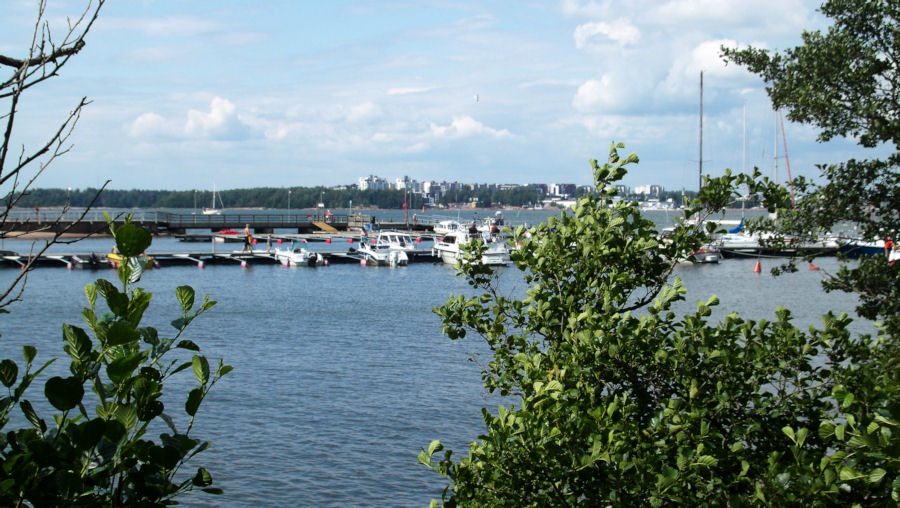 View
of the public pontoon area where we initially landed, taken from
our quieter location in the nearby lagoon.
This was just one of a multitude of islands in the immediate vicinity of Helsinki. - click here for larger image 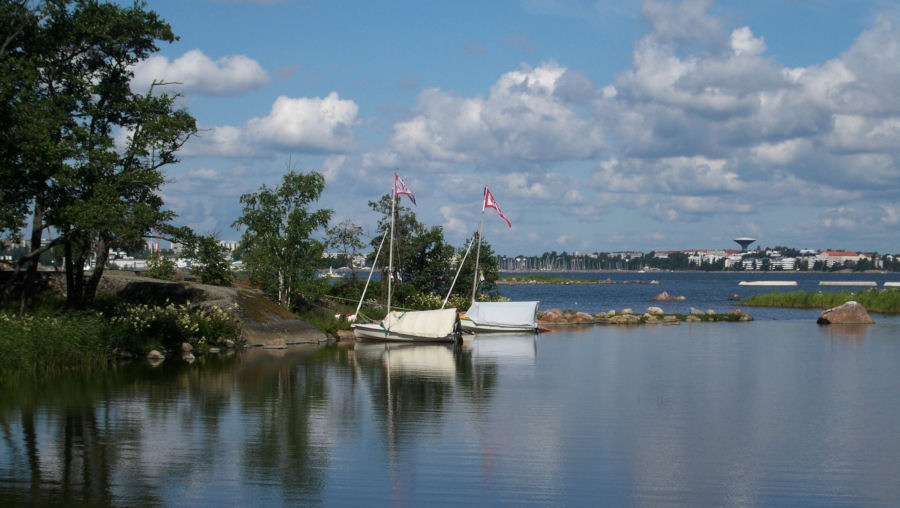 The
entrance to this quiet lagoon was very shallow, which appeared to
preclude other boat users from venturing into it.
It was probably the most perfect location we could have found to stay for the next five days. - click here for larger image Since it was the height of the holiday
season, the ferry to pick up the
cars and trailers to return the boats to Stockholm had needed to be
booked
prior to the trip. We had allowed three weeks to complete the cruise,
and we had
arrived with just 2 days to spare. We
spent these two days sightseeing in Helsinki before Martin and
Åke caught the
ferry back to Stockholm, with Ralph and Sten remaining with the boats
Rönnskär
until they returned two days later.
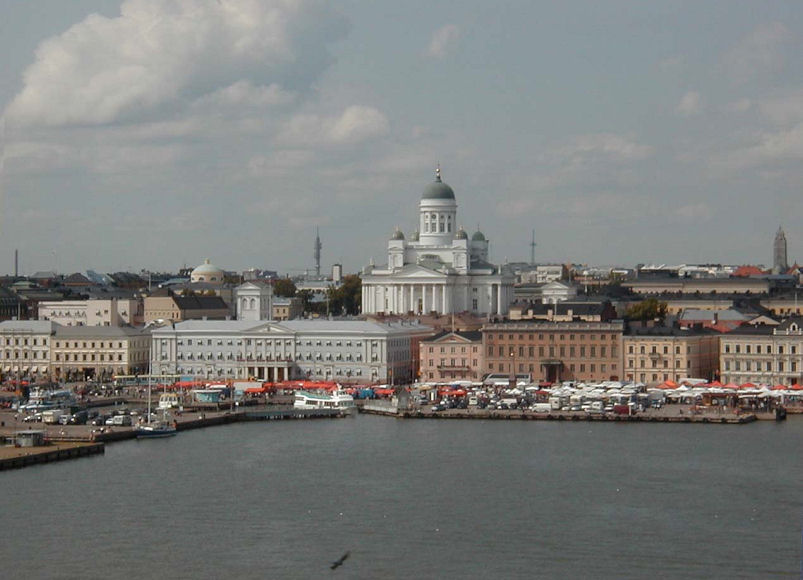 Sten Willstrand and
Åke Nilsson - (with photo captions and editing by
Ralph Roberts - W9885)
|
| return to Baltic Log index return to logs index |